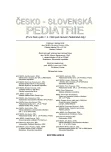Urinary Tract Infection in Children and Adolescents, Recent Data on Etiology, Diagnostics and Therapy
Authors:
J. Janda 1; E. Sládková 2; J. Zůnová 2
Authors‘ workplace:
Pediatrická klinika FN Motol, Praha
přednosta prof. MUDr. J. Lebl, CSc.
1; Dětská klinika FN, Plzeň
přednosta doc. MUDr. J. Kobr, PhD.
2
Published in:
Čes-slov Pediat 2010; 65 (12): 706-714.
Category:
Review
Overview
Urinary tract infections (UTI) are the second most common cause of morbidity in children, only respiratory infection reveals a higher rate. Infants and toddlers are at highest risk of permanent damage of the renal parenchyma, particularly in inadequately treated urinary infection. Primary care pediatricians should take in account the possibility of acute pyelonephritis, firstly in children with high fever without symptoms of respiratory problems. In cases of suspected acute pyelonephritis, the child should be admitted to a hospital for intensive antibacterial therapy, during the first 2–3 days application i.v.
This review summarizes the new insights, particularly concerning the modern investigative methods and their impact on the treatment. Approach to examinations of children with UTI has been changed during the last decades showing some news reflecting the impact of “evidence based medicine” studies and progress of the diagnostic techniques. Besides the classical treatment with antibiotics and chemotherapeutics the authors assess critically also the use of cranberries, E. coli extracts and use of probiotics.
Key words:
urinary tract infection, pyelonephritis, pyelonephritic cicatrices, vesicourethral reflux, examination methods, therapy
Sources
1. Chromek M, Slamova Z, Bergman P, Kovacs L, Podracka Ľ, et al. The antimicrobial peptide cathelicidin protects the urinary tract against invasive bacterial infection. Nat. Med. 2006; 12(6): 636–641.
2. Hawn TR, et al. Toll-like receptor polymorphisms and susceptibility to urinary tract infections in adult women. PLoS ONE 2009; 4(6): e5990.
3. Liptáková A, Podracká L, Siegfried L. Urinary tract infections in children caused by uropathogenic strains of Escherichia coli and the role of the innate immune response mediated by the toll-like receptor 4 and antimicrobial peptide cathelicidin in their clinical course. Epidemiol. Mikrobiol. Imunol. 2007; 56: 72–77.
4. Polito C, Rambaldi PF, Signoriello G, Mansi L, La Manna A. Permanent renal parenchymal defects after febrile UTI are closely associated with vesicoureteric reflux. Pediatr. Nephrol. 2006; 21(4): 521–526.
5. Gokce I, Alpy H, Biyikli N, et al. Urinary levels of interleukin-6 and interleukoin-8 in patients with vesicoureteral reflux and renal parenchymal scar. Pediatr. Nephrol. 2010; 25: 905–912.
6. Coulthard MG, Kalra M, Lambert HJ, Nelson A, Smith T, Perry JD. Redefining urinary tract infections by bacterial colony counts. Pediatrics 2010; 125(2): 335–341.
7. Verrier JK. International Conference on Vesicoureteral Reflux in Children, Göteborg, June 4–6, 2009.
8. Darge K, Grattan-Smith JD, Riccabona M. Pediatric uroradiology: state of the art. Pediatr. Radiol. 2010 Apr; 21 (Epub ahead of print).
9. Herd DW, McAnulty KA, Keene NA, Sommerville DE. Conscious sedation reduces distress in children undergoing voiding cystourethrography and does not interfere with the diagnosis of vesicoureteric reflux: A randomized controlled study. Am. J. Roentgenol. 2006; 187: 1621–1626.
10. Papadopoulou F, Anthopoulou A, Siomou E, Efremidis S, Tsamboulas C, Darge K. Harmonic voiding urosonography with a second-generation contrast agent for the diagnosis of vesicoureteral reflux. Pediatr. Radiol. 2009; 39(3): 239–244.
11. Leitlinien der Deutschen Gesellschaft für Nuklearmedizin, AWMF – Leitlinien-Register Nr. 031/041 .
12. Smith EA. Pyelonephritis, renal scarring, and reflux nephropathy: a pediatric urologist’s perspective. Pediatr. Radiol. 2008; 38(Suppl 1).
13. Neuhaus TJ, Berger Ch, Buechner K, et al. Randomised trial of oral versus sequential intravenous/oral cephalosporins in children with pyelonephritis. Eur. J. Pediatr. 2008; 167: 1037–1047.
14. Leroy S, Chalumeau M, Ulinski T, et al. Impressive renal damage after acute pyelonefritis in a child. Pediatr. Nephrol. 2010; 25: 1365–1368.
15. Mori R, Fitzgerald A, et al. Antibiotic prophylaxis for children at risk of developing urinary tract infection: a systematic review. Acta Paediatr. 2009; 98(11): 1781–1786.
16. Keren R, Carpenter MA, Hoberman A, et al. Supplement article. Rationale and Design Issues of the Randomized Intervention for Children With Vesicoureteral Reflux (RIVUR) study. Pediatrics 2008; 122(Suppl): S240–S250.
17. Dai B, Liu Y, Jia J, Mei C. Long-term antibiotics for the prevention of recurrent urinary tract infection in children: a systematic review and meta-analysis. Arch. Dis. Child. 2010; 95(7): 499–508.
18. Jepson RG, Craig JC. Cranberries for preventing urinary tract infections. Cochrane Database Syst. Rev. 2008; 1(1): CD001321.
19. Ferrara P, Romaniello L, Vitelli O, Gatto A, Serva M, Cataldi L. Cranberry juice for prevention of recurrent urinary tract infeaction in children. A randomized controlled trial in children. Scand. J. Nephrol. Urol. 2009; 43(5): 369–372.
20. Reid G, Bruce AW. Probiotics to prevent urinary tract infections: the rationale and evidence. World J. Urol. 2006; 24(1): 28–32.
21. Lettgen B. Prevention of recurrent urinary tract infections in female children: OM-89 immunotherapy compared with nitrofurantoin prophylaxis in a randomized pilot study. Curr. Ther. Res. 1996; 57: 464–475.
22. Cruz F, Dambros M, Naber KB, et al. Recurrent urinary tract infections: Uro-Vaxom®, a new alternative. Eur. Urol. 2009; 8(Suppl): 762–768.
23. Kun Suk Kim, Ji-Yoon Kim, In Gab Jeong, Jae-Seung Paick, et al. A prospective Multi-center trial of Escherichia coli extract for the prophylactic treatment of patients with chronically recurrent urinary tract infection. J. Korean Med. Sci. 2010; 25: 435–439.
24. Meredith M, Chiavaroli C, Bauer HG. Immunotherapy for recurrent urinary tract infections: Effects of an E. coli extract. Curr. Urol. 2009; 3: 1–8.
25. Handley MA, Reingold AL, Shiboski S, Padian NS. Incidence of acute urinary tract infection in young women and use of male condoms with and without nonoxynol-9 spermicides. Epidemiology 2002; 13(4): 431–436.
Labels
Neonatology Paediatrics General practitioner for children and adolescentsArticle was published in
Czech-Slovak Pediatrics

2010 Issue 12
Most read in this issue
- Autoimmune Liver Diseases in Children. Part I
- Unilateral Multicystic Dysplasia of the Kidneys (A Cohort of Patients)
- Current Role of Diuretic Renal Scintigraphy in Childhood. Review
- Urinary Tract Infection in Children and Adolescents, Recent Data on Etiology, Diagnostics and Therapy
